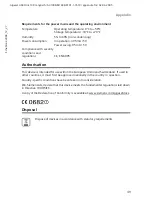
39
Glossary
Gigaset USB Stick 108 / englisch / A31008-M1038-R101-1-7619 / glossary.fm / 02.06.2005
Sc
hablone 2
004_
12_2
7
Hub
A Hub connects several network components in a star-topology network by sending all
the data it receives from one network component to all the other network components.
See also Bridge, Gateway, Router, Switch
IEEE
Institute of Electrical and Electronics Engineers
IEEE is an international body for defining network standards, especially for
standardising LAN technologies, transmission protocols and speeds, and wiring.
IEEE 802.11
IEEE 802.11 is a standard for wireless 2.4-GHz band LANs. In infrastructure mode, end
devices can be connected to a base station (Access Point) or connect with each other
spontaneously (ad-hoc mode).
Infrastructure mode
Infrastructure mode is a way of operating wireless local networks (WLAN), in which an
Access Point handles the data traffic. Network components cannot establish a direct
connection with each other as is the case in ad-hoc mode.
Internet
The Internet is a WAN (= Wide Area Network), linking several million users around the
world. A number of protocols have been created for exchanging data, and these are
known collectively as TCP/IP. All participants on the Internet are identifiable by an
IP address. Servers are addressed by a domain name (e.g. siemens.com).
Domain Name Service (DNS) is used to assign domain names to IP addresses.
Among the most important Internet services are:
u
electronic mail (email)
u
the World Wide Web (WWW)
u
file transfer (FTP)
u
discussion forums (Usenet / Newsgroups)
Internet Service Provider
An Internet Service Provider offers access to the Internet for a fee.
IP
Internet Protocol
The IP protocol is one of the TCP/IP protocols. It is responsible for the addressing of
participants in a network using IP addresses and routes data from the sender to the
recipient. It decides the paths along which the data packets travel from the sender to
the recipient in a complex network (routing).
















































